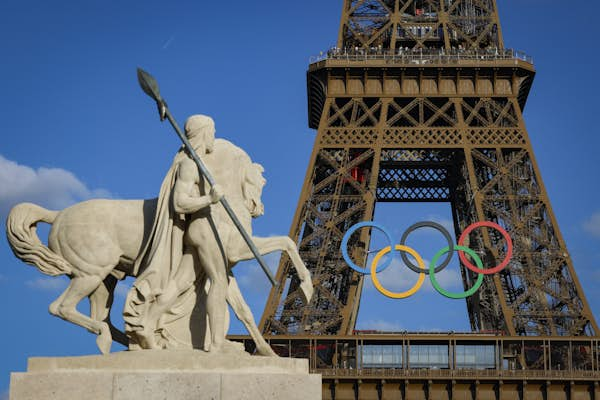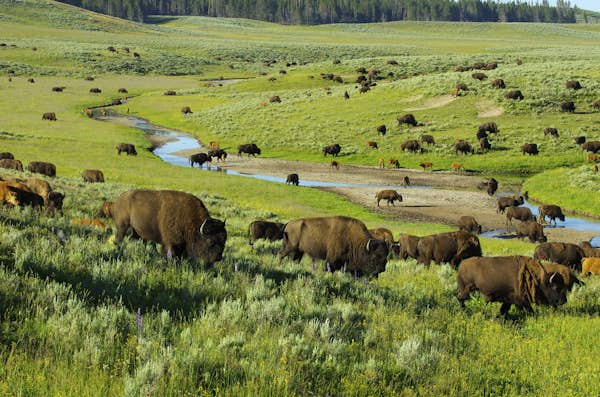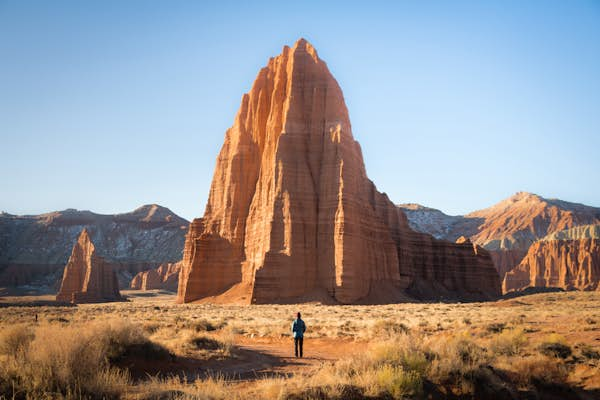


Navigating Paris during the Olympics: how to avoid transport fare increases and more
With an estimated 15 million visitors expected to descend on the French capital during the Olympic and Paralympic games, Paris’s public transportation system and security forces will be under immense pressure.
In the lead-up to the games, which start after the opening ceremony July 26 and end September 8, a flurry of new metro fare announcements, road and metro closures and security measures have caused confusion even among the locals.
So it goes without saying that visitors can be forgiven for feeling overwhelmed by information overload as well. To help clear up the confusion, here’s a break-down of how to best navigate Paris (during the Olympics, but also after) and how new security rules will impact your travels:
What documents do I need to prepare for my visit to the Paris 2024 Olympics?
Holders of American, Canadian, British and (of course) EU passports can travel to France visa-free if their stay is less than 90 days. If you’re not from any of these countries, the government has a clever portal called the “visa wizard” that will tell you if you need a visa for your visit, and the kinds of travel documents you’ll need to bring.
Where are the Paris 2024 Olympics taking place?
In Paris, the games will be spread out across 15 Olympic and 11 Paralympic sites and extend beyond the Paris perimeter to suburbs like Les Yvelines to Hauts-de-Seine, Seine-et-Marne and Seine-St-Denis.
Certain events such as soccer, handball, basketball and sailing will be held in Bordeaux, Nantes, Lyon, St-Etienne, Nice and Marseille.
The surfing competition will be held in the overseas territory of Tahiti.

Are metro tickets really double the price during the Olympics?
The rumors are true. The cost of a metro ticket in Paris is set to double during the Olympics. But only for visitors who leave things to the last minute and don’t plan ahead. From July 20 to September 8, the price of a single metro ticket will rise from €2.15 to €4.
But there’s a way to bypass this entirely with just a little advance planning.
By downloading the regional transport authority’s app on your smartphone before July 20, visitors can buy single tickets at the regular fare of €2.15 per ticket in advance. You can also save a bit more if you buy a book of 10 tickets for €17.35 (a reduced fare of €1.73 per trip). Users can store up to 30 tickets at a time and buy top-up tickets as you go. It’s a handy way to avoid long line-ups at ticket kiosks. Just scan your phone at the metro turnstile and you’re on your way.
For those who prefer an actual metro card, you’ll want to buy a Navigo Easy pass at metro stations or at approved sellers like tobacco shops and newspaper kiosks for €2. Cards are rechargeable, and tickets can be purchased from the app and loaded directly on the card: just hold the Navigo pass to the top of the phone. For the less tech savvy, cards can still be topped up at metro stations as well.
New Olympic daily pass
Visitors can also purchase a specially created daily Paris 2024 Pass, which starts at €16 for 1 day and gives users unlimited access to all competition venues in Île-de-France, as well as Orly and Roissy Charles-de-Gaulle airports. Fares are on a sliding scale and get cheaper as you go: for example, a 7-day Paris 2024 pass works out to €10 a day (€70 for 7 days). This pass can also be purchased from the app or at train stations and ticket machines and is valid for use between July 20-Sept. 8.
After September 8, fares will return to normal pricing. Future visitors should also consider downloading the transportation app in order to avoid line-ups at metro stations and save a few euros.
New service to Orly airport
If you’re flying in and out of Paris-Orly airport, a new extension on metro line 14 linking the airport to the city center was recently inaugurated. Flyers arriving at Orly can now take the metro line to popular transfer and stop-off stations like Châtelet and Saint-Lazare, all the way up to the northern suburb of Saint-Ouen. Just remember that fares to the airport are not included in the standard metro rates and are an additional €10.30 per trip.

Station closures to be aware of:
While mapping out your metro itinerary, keep in mind that the following stations will be closed throughout much of the summer until September 21:
Concorde, Tuileries, Champs-Elysées – Clemenceau
A full list of closures and reduced metro service between July 18-25 can be found here. To find the best metro itinerary with up-to-date information on closures and service disruptions, Google Maps is pretty reliable, as are the apps for the Paris metro Bonjour RATP and the regional transport authority Île-de-France Mobilités.
Users can also use the Bonjour RATP app to rent any one of the 35,000 bikes from Dott, Lime Tier and Vélib.
Do I need a QR code to get around Paris during the games?
It depends on a lot of factors, including your mode of transport, your dates of travel, and the location of your destination. But sorting out the rules requires wading through a maze of conditions and exceptions.
The Pass Jeux or Games Pass is a digital pass or QR code that allows holders to access sensitive security areas, particularly in the lead-up to the opening ceremony. For the first time in Olympic history, the opening ceremony will be held outdoors on the Seine river, rather than a stadium—a spectacle that carries with it huge security challenges.

In the days leading up to opening ceremony
From July 18-26, if your hotel or restaurant reservation is in the high security grey zone along the Seine, and you will be traveling on foot or by bike, you will need to apply for a QR code to justify your access to the area. Cars, including taxis and ride-shares, are strictly prohibited.
This doesn’t apply, however, to ticket holders for attractions located in the area. Those who hold confirmed bookings are exempt from having to apply for a QR code and can simply present their ticket at security checkpoints. That includes the Louvre and Orsay museums, the Musée du quai Branly – Jacques Chirac (all of which will be closed July 25-26), the Eiffel Tower (closed July 26) and the Institut du Monde Arabe.
Note that all river cruise excursions will be suspended between July 20-26.
Outside the grey zone and into the broader red perimeter, pedestrians, cyclists and scooters are allowed to move freely without a QR code. If traveling by taxi or ride-share, you don’t need the QR code but you must be able to present proof of a hotel, museum or restaurant reservation to gain access to the area.
After the opening ceremony
Between July 27-August 11 and then for the Paralympics August 28-September 8, areas around competition sites will become red zones up to 2.5 hours before a sporting event, and for an hour afterwards. Pedestrians and cyclists won’t require a QR code, but those planning to travel in a taxi or ride-share in the area will be required to present a Games Pass.
Along with the digital pass, make sure you have your photo ID, along with proof of accommodation or reservations on you to present to police.
Ticket holders of Olympic sporting events do not need a QR code to access the sites.
If you’re not sure, check the interactive map to see if your destination falls in one of the security zones.
Digital passes are free and not required for those under 13.
QR codes can be obtained on the platform Pass Jeux and require applicants to send photo ID and proof of reservations.
The main takeaway: if you want to avoid traffic headaches, the best way to get to your destination, be it a competition venue or restaurant, is to take public transport, walk or bike—modes that also align well with the Paris Olympics’ sustainability goals.

Visiting other French cities for the Olympic games? Here’s how to navigate France’s rail network
Keep in mind that France’s ban on domestic short-haul flights of under 2.5 hours for trips that can be completed by train came into force in 2022. That means that if your Olympic events are in cities like Nantes, Bordeaux and Lyon, your only option (unless you plan to drive yourself) is the train. Luckily, this also happens to be the easier and less stressful method of transportation.
That said, the different rail operators in France can cause confusion. Here’s a quick primer on the different rail lines and operators:
- The SNCF is the national rail service and operates the country’s high-speed TGV trains. A trip from Paris to Lyon on a high-speed train, for, instance, takes about two hours. This will be your first stop when looking up train tickets to other host cities.
- Inoui designates premium seats and service.
- Ouigo is the low-cost version of the SNCF, but tickets and times are more limited.
- Trains operated by Intercité serve cities without high-speed train routes and connect major cities without the need to transit from Paris. Routes include Nantes–Bordeaux and Toulouse–Marseille. The outfit also operates night-train services connecting Paris with cities like Nice, Lourdes and Toulouse.
- TER (Transport Express Régional) trains connect cities and smaller towns within the country’s 12 regions in metropolitan France.
- Transilien is the equivalent of the TER but for the region of Île-de-France.
- The RER (Réseau Express Régional) is a commuter line that operates within Paris and its suburbs.

The logistics of planning a trip for the Olympics may seem daunting at first, but knowing your options and understanding how all the systems – for match ticketing, accommodations and transportation – work will hopefully make the picture clearer so that you can look forward to being a part of history.

A first-time guide to Yellowstone National Park
America’s oldest national park, Yellowstone has been captivating visitors since the 1870s. Lofty mountain peaks, thundering waterfalls and abundant wildlife are all big draws of this 3471-square-mile park, but even more extraordinary are Yellowstone’s geothermal features. This is the land of boiling geysers, gurgling mud pools and steaming lakes. Traveling in this remote corner of northwestern Wyoming can sometimes feel like exploring another planet.

When should I go to Yellowstone?
Most people plan a trip during the summer season, from June to early September. This is when all of the roads, campgrounds and trails are open (though snow is still possible at higher elevations through early July). Unfortunately, it’s also a very busy time with congested roads and sizable crowds at key destinations (like Old Faithful).
You can beat the crowds and higher accommodation prices by coming just before or after the high season (May or October). For a different perspective on Yellowstone, visit during the winter when access is generally by special snow coach (buses with huge snow tires). Several lodges in the park stay open in the winter, and you can arrange tours by ski and snowshoe.
How much time should I spend in Yellowstone?
With five far-flung entrances, Yellowstone is enormous, and you could easily spend a week here and not run out of things to see and do. If you have only a long weekend, spend your first day on the west side of the park, where you’ll find the most impressive geothermal features – like Old Faithful, Norris Geyser Basin and Mammoth Terraces.
On day two, head east to the Grand Canyon of the Yellowstone, then have a look at scenic Yellowstone Lake – particularly the area around West Thumb, which also has geysers and bubbling hot springs.
If you have four days to spare, you can also fit in some wildlife watching in the Lamar Valley, squeeze in a challenging hike or two and not have to rush your time at park visitor centers. Park-run museums near Old Faithful and the Grand Canyon of the Yellowstone give insight into the park’s natural history, its wildlife and the geological forces at work deep beneath the earth’s surface.
Is it easy to get in and around Yellowstone?
The main gateway airports are in Jackson (56 miles), Bozeman (65 miles) and Billings (129 miles). There’s also the tiny West Yellowstone airport, though it has limited and pricey summer services. Once you fly in, you’ll need to rent a car as there is no bus service available in the park.
With lots of cars on park roads, you’ll need to plan carefully: head out early to your top destination of the day to avoid traffic snarls, and pack plenty of patience. Traffic jams are often caused by bison, who sometimes decide they want to take a stroll right down the middle of the road. Just remember that this is their land, and we’re the interlopers. You’ll simply have to wait until they move safely out of the way.

Top things to do in Yellowstone
The star of Yellowstone is Old Faithful, so named for its regular eruptions, which typically happen every 90 minutes. There are many fine vantage points for seeing the thundering geyser, including the observation deck of the Old Faithful Inn, where you can purchase a cold drink (Old Faithful Ale naturally) while enjoying nature’s finest show. Afterwards, you can explore the Geyser Basin, which is packed with geothermal wonders.
A nearby must-see is the Grand Prismatic Spring with its psychedelic hues. Take the easy-going boardwalk loop, but for a better perspective be sure to also take the short hike up the Fairy Trail to the overlook above the spring.
The Grand Canyon of the Yellowstone is another spectacular site that should figure high on any itinerary. The dramatic canyon snakes for some 20 miles, and its fairly steep walls boast a range of colors in subtle shades of orange, pink and auburn. Several waterfalls thunder through canyon: Head to the Brink of the Lower Falls to stand just above the roaring cascade, then lose the crowds by taking a hike along the North Rim, where you’ll enjoy some sweeping views of the falls as you walk through the forests beyond the canyon’s edge.
Most visitors stick to the boardwalk trails, but if you’re eager to see the backcountry, you’ll have plenty of options among the park’s 1000 miles of trails. For bragging rights, make the climb up Mt Washburn, which sits at an elevation of 10,219 feet. The 6.8-mile roundtrip takes you to an overlook with 360-degree views, and there’s a good chance of spotting wildflowers and bighorn sheep along the way.
My favorite thing to do in Yellowstone
I love to rise early and head to the Lamar Valley. Sometimes referred to as the Serengeti of the US, the Lamar Valley is home to some of the largest herds of bison and elk in North America. Just after sunrise, the wildlife-watching is at its best, and there’s a good possibility of seeing not just the big ungulates, but also pronghorn (North America’s fastest land animal), moose and bighorn sheep. On lucky days, I’ll even see wolf packs, which come to hunt the elk – their favorite prey.

How much money do I need for Yellowstone?
Unless you’re camping, you’ll need a decent budget to properly experience Yellowstone. In-park lodging soars during the short summer season, and the limited accommodation options at nearby towns also get pricey then. You’ll need to factor in the cost of car rental and fuel as well, since it’s not practical to explore the park without a vehicle (unless you’re coming in the winter). If you’re willing to rough it a bit, a small two-person cabins without bathrooms start at $150 per night.
Some average daily costs are as follows:
- Lodge room in the park: $150-600
- Hotel room outside the park: $250
- Park pass (valid 7 days): $35 per vehicle
- Campsite: $25-50
- Full-day tour per person: from $170
- Coffee drinks: $4-8
- Craft beer at the bar: $6-9
- Lunch: $12-20
- Upscale dinner for two: $120-200
-

Get bear aware before venturing in Yellowstone National Park © Frank Fichtmueller / Shutterstock
Bears and hiking
When hiking in grizzly country, stay alert and make plenty of noise – and avoid hiking alone. Never hike before dawn or after dusk. If you encounter a bear at close range, don’t run. Instead, back away slowly. If it charges, deploy your bear spray.
Bear spray?
Indeed, you should never hike in Yellowstone without carrying bear spray and keeping it within easy reach (on your belt, not buried in your backpack). Purchase a canister when you arrive (you can’t transport it on planes). It’s available at many stores, including within the national park. For a quick overview on using bear spray, read more here.
Leave the fuzzy cows alone
In truth, bears aren’t the most lethal creatures in Yellowstone. More people have been injured or killed by bison. Never approach bison or other wildlife, and give ample space to these seemingly docile creatures, who will charge if they feel threatened.

Geothermal hazards
Stay on the trail when hiking, and don’t stray from the boardwalk when visiting geothermal areas. Ignoring these warning signs can land you in a lot of trouble with the law (as actor Pierce Brosnan discovered earlier this year), not to mention you could be seriously hurt if you fall into a boiling spring or a steam vent.
Packing tips
Even on a cloudless summer day, it’s wise to pack a waterproof shell jacket and a knit cap. Wear layers that you can peel off as needed. The mountain weather is ever changeable, so always be prepared for the rain and cold.
Wildlife-watching etiquette
If you see something from the road and want to have a look, don’t park in the road and block traffic. Use pullouts and make sure your wheels are all the way off the main road when parking.

9 of the best places in the US to escape the crowds
With its epic expanse and diversity of landscapes, it seems like it should be easy to find some solitude in the USA.
But that’s not always the case, with some of the country’s beauty spots getting clogged with visitors, particularly during the summer high season. That’s why we asked our expert writers and staff to share some of their favorite places in the country to find some space.
Here are 9 of the best places in the US to escape the crowds.
1. Capitol Reef National Park, Utah
Recommended by Deepa Lakshmin
The thing about hiking at popular national parks is that you will inevitably get stuck in a bottleneck waiting to scramble over a rock or shuffle through a narrow path. That can kill the mood, so I was pleasantly surprised by how quiet Capitol Reef – one of Utah’s Mighty 5 national parks – was.
I hiked two trails, Sulfur Creek and Cohab Canyon, that were gloriously empty. Following Sulfur Creek through slot canyons and over waterfalls was my favorite, because the 5.8-mile trek feels completely untouched by humans. No trail markers, no signs, no bathrooms, no trash cans: just you in the wild. (And preferably a guide who knows where to go. I’m a newbie hiker and wouldn’t do this solo, especially because the water level can rise as high as your chest depending on conditions.)
Stay in Torrey, UT for easy access to the park; I checked out the new Skyview Hotel on a trip last year, which is ideal for glamping under the stars. There aren’t a ton of accommodation or dining options in such a small town, but that also means there’s really no wrong choice. Wild Rabbit Cafe is a must for breakfast, and have a nice sit-down dinner at Hunt & Gather. Fun extras are a cider tasting at Etta Place and a massage at Red Sands’ spa. Your muscles will thank you after all that trekking.

2. Montana Badlands
Recommended by Bailey Freeman
Montana’s mountains may attract most of the state’s attention, but its eastern badlands are perfect for those looking to truly escape it all. Characterized by striking landscapes, dinosaur fossils, dark skies, and a perplexing lack of tourists, this well-kept secret will illuminate Earth’s staggering history – with hardly another visitor in sight.
Hike through the pyramid-like mounds that punctuate the prairie in the Terry Badlands, or camp on top of the banded cliffs that make the whole area look like a painting. Just down the road, you can also wander the otherworldly hoodoos and cliffsides of Makoshika State Park, one of Montana’s hot spots for dinosaur fossils; both Triceratops and Tyrannosaurus Rex fossils have been found here, and scientists are discovering more specimens all the time. At night, the sky opens up to a flood of stars that overlook the ancient terrain; bring a telescope or a camera and scope out the wonders of the heavens.

3. Coldfoot, Alaska
Recommended by Erin Kirkland
Unpretentious and built for function in Alaska’s far north, the tiny community of Coldfoot delivers for people wanting to experience Alaska’s remote spaces and adventurous activities. Essential as a truck stop for drivers transiting the Dalton Highway across the Arctic Circle, visitors arrive via auto (note that most rental agencies will not allow travel along this mostly gravel road) along the highway, or by air, thanks to several small carriers out of Fairbanks, 253 miles south.
Coldfoot sits at the base of the stunning Brooks Range and provides access to year-round recreation. From June 1 to mid-September, stop at the Arctic Interagency Visitor Center for information, maps, ranger-led presentations, and interpretive displays showing the region’s history. Coldfoot Camp can assist travelers wanting to hike or raft deeper into the Brooks Range and Gates of the Arctic National Park and Preserve or Arctic National Wildlife Refuge, with gear and guides provided. In the fall and winter months, Coldfoot becomes a top place to view the sweeping and colorful northern lights. Nightly tours departing from Coldfoot Camp with options to add snowshoeing or fat biking to the adventure.

4. Hovenweep National Monument, Four Corners, USA
Recommended by Liz Prado
Surrounded by high desert and stunning red rock canyons, Hovenweep National Monument is a little-visited archaeological zone in the Four Corners region, where Arizona, New Mexico, Colorado and Utah meet. It’s a place to escape the throngs at nearby national parks and imagine what life was like long ago. The one-time home of the Ancestral Puebloans, Hovenweep is a cluster of six ancient villages built between 1200 and 1300 CE and peppered across Colorado, Utah and the Navajo Nation. Wide expanses of dirt roads and trails connect the sites, a treasure trove of teetering towers and sacred kivas perched on canyon rims.
The largest and easiest to access is the Square Tower Group, a clutch of well-preserved structures along a 2-mile trail near the visitor center in Utah. There’s a first-come-first-served campground as well as ranger-led programming. The other archaeological sites are between 4 and 9 miles away; before heading out, ask about trail and road conditions and grab a map as GPS is unreliable and cell service almost nil. Wherever you explore, stay for the stargazing – Hovenweep is also one of the world’s rare gold-tier International Dark Sky Parks, where up to 15,000 stars can be seen on cloudless nights.

5. Superstition Mountains, Arizona
Recommended by Melissa Yeager
Eager hikers visiting Phoenix swarm iconic Camelback Mountain in Scottsdale to get a photo from the humpback-shaped mountain for their Instagram. The resulting crowds along the less-hiking, more-bouldering route make it one of my least favorite hiking experiences in Arizona. Break free of the crowd, and take the drive east on Hwy 60 to the Superstition Mountains. The desert dazzles in this area, with stunning saguaro cacti and views for days.
Hieroglyphic Trail will give you a less intense hike with the payoff of seeing petroglyphs near a waterfall. More intermediate hikers will find Fremont Saddle a delightful route. (Bring a lunch to enjoy at the top as you rest and admire sweeping views of Weavers Needles.) Experienced hikers looking for a rugged challenge can hike and climb the boulders for a spectacular view of the region from the top of Flat Iron. The Superstitions are gorgeous but wild. Cell service in the area is scarce, and in some places you’ll need a car that can navigate unpaved roads. Make sure to bring enough water for your trip as trailheads may not have public water dispensers.

6. The Shenandoah Valley, Virginia
Recommended by Ann Douglas Lott
Surrounded by Virginia’s Blue Ridge Mountains and West Virginia’s Alleghany Mountains, with the Shenandoah River flowing its entire length, this 140-mile stretch of paradise is often overshadowed by the majestic mountain ranges of the western US. But this place practically begs to be your next scenic road trip. Drive the curving roads of the Blue Ridge Parkway or Skyline Drive, or meander along wide open back roads (or follow I-81 if you’re short on time), stopping into charming, historic small towns like Staunton, Harrisonburg and Lexington for antiquing and brewery-hopping. Chill out at sprawling vineyards, pick up fresh bread from a local farm or relax under curtains of fragrant lavender at a lavender farm. Then get outside and trek a section of the Appalachian Trail found inside the state’s big and beautiful beast: Shenandoah National Park. The slogan “Virginia is for lovers” rings true in the Shenandoah Valley. Life moves enchantingly slowly, and the romance of the rolling Blue Ridge Mountains is undeniable. Oh, and once you’ve experienced your first Shenandoah sunset, you’re hooked.

7. Bellingham, Washington
Recommended by Chamidae Ford
In western Washington, trees and waterfront collide for unmatched beauty. If you’re looking for a town that truly encapsulates the PNW spirit but lacks the crowds, Bellingham is for you. Nestled 30 minutes from the Canadian border, Bellingham is a quaint and idyllic oasis bursting with outdoor activities. Opt for a slight detour along Chuckunut Drive rather than I-5 to fully experience the region’s beauty. Chuckanut provides excellent views of Sammish and Bellingham Bay, with tons of hikes (Oyster Dome is a favorite) and viewpoint stop-offs.
In town, grab lunch at Mambo Italiano — the sandwiches made with in-house focaccia are unforgettable. Browse the indie bookstore, Village Books, for your next great read, and in the summer, head to their lawn on Mondays for an outdoor movie. Ride your bike along the bay or enjoy a sunset picnic along the water at Boulevard Park. You can’t visit the PNW without stopping by one of the numerous breweries in the area; it’s a classic local hang. Otherlands Beer is a stellar option for top-notch brews and good vibes. And when you need a late-night snack, stop by the beloved college haunt, AB Crepes.

8. Channel Islands National Park, California
Recommended by Brekke Fletcher
If you’re looking to get off the grid and are willing to hop on a boat, then the Channel Islands National Park is for you. Located off the coast of Southern California, between Santa Barbara and Los Angeles, this wildly wonderful archipelago carries the distinction of being one of California’s least-visited national parks. To get there, you’ll need to take a tour with an outfit like Island Packers, which provides two points of departure from Ventura and Oxnard.
Five islands make up the park: San Miguel, Santa Rosa, Santa Cruz, Anacapa and tiny, southern Santa Barbara, which is much further south. Visiting any one of them allows you to see and experience a place that is mostly as it was for tens of thousands of years. From land and sea, behold stunning, rugged landscapes and look out for some of the 150 plant species and a few animals that are unique to the islands. If you wish to lengthen your time on the islands there are several campgrounds for overnight stays you can reserve in advance. And if you plan to visit between June and November, you can add whale-watching to your excursion.

9. Jayuya, Puerto Rico
Recommended by John Garry
Just a domestic flight from the mainland US, travelers heading to Puerto Rico and searching for solitude should head to Jayuya, nestled in the Central Mountains. Here, crowds of a different kind dominate – like choirs of coqui frogs and gangs of roving roosters. Legend says native Taíno populations escaped Spanish persecution by hiding in the Central Mountains until the mid-19th century, and now, Jayuya serves as the island’s Indigenous epicenter, with museums celebrating local heritage and ancient petroglyphs aplenty.
It’s easy to see how Jayuya held on to its traditions. Imposing mountain peaks protect the town – including the 4398ft Cerro de Punta – and even today, the only way to get here is along razor-thin roads that twist and tumble like a roller coaster. Those who brave the journey reap major rewards: barely-trafficked hikes around Toro Negro State Forest, tiny group tours at working coffee farms like Hacienda San Pedro and jungle pools fed by waterfalls like Cascada Las Delicias. After a dip in Jayuya’s chilly waters, head to La Destileria Craft Spirits for a taste of pitorro, a locally-made moonshine rum that will warm your soul.





